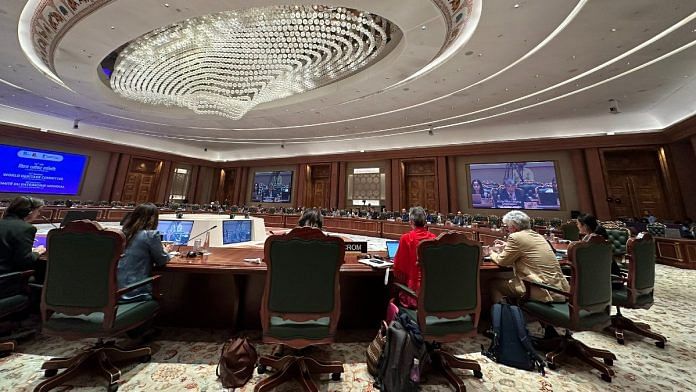New Delhi: At the 46th annual meeting of the World Heritage Committee meeting held at the Bharat Mandapam here Monday, stakeholders from around the globe stressed the need for the list of World Heritage Sites to comprise a more diverse range of culturally and environmentally significant regions and properties.
Presently, the West has a disproportionate hold over the list — with four of the top five countries in terms of representation, being European — while entire geographical areas, such as the African continent, are colossally under-represented.
Africa currently has 98 sites on the list, out of a total of 1,199.
A range of member and observer nations held forth on this at the meeting, which was presided over by India’s Permanent Ambassador to UNESCO, Vishal Sharma, and had India as host nation for the very first time.
The discussion, ongoing from 21 July, will conclude by 31 July.
“The mentorship programme of Africa stands as a significant achievement of the World Heritage Center, alongside the training of underrepresented parties towards an inclusive and sustainable heritage programme,” said the Indian delegation. “We extend our appreciation. However, the challenges are enormous. The workload of the secretariat is increasing constantly, while it faces long-term problems.”
Issues at hand include global conflict, climate change, mass urbanisation — all of which require effective management that prioritise local communities, the delegation added.
Conservation efforts are currently facing these interlinked threats, which will only be exacerbated over the coming years. Small Island Developing States (SIDS), home to ecologically rich and biodiverse regions, are particularly vulnerable.
On account of these challenges, Chrissy Grant, chairperson of the International Indigenous People’s Forum for World Heritage, highlighted the “indissoluble” bond between culture and nature.
“Cultural and natural values are presently evaluated separately. Natural sites are designated without recognising the cultural values of indigenous people,” she said, adding that while steps have been taken in the right direction, there is still a “lack of respect” with which people view indigenous communities.
She further demanded the “direct and meaningful participation” of these communities in the formulation of systems and policies that affect them.
While presenting the committee report, Grant also acknowledged the slew of challenges that stand in the way of the World Heritage Committee towards realising its full potential. Apart from the cascade of human-induced climate change-related issues, these include financial constraints.
“Initiatives, programmes and capacity-building projects aim to address these constraints [financial and capacity-building limitations] by empowering local communities and building expertise among heritage professionals,” reads the report. “However, limited funding and human resources hinder the scale and impact of these initiatives.”
Also Read: Israeli officials, Palestinian delegation to arrive in Delhi for UNESCO event hosted by India
India’s push for Chardeo Moidams
The World Heritage Committee exists to prescribe properties with world heritage status, while also ensuring the implementation of The World Heritage Convention (1972), an international document which provides a framework for the preservation of natural and cultural properties. The Committee has 21 member states; India ratified the convention in 1977.
As of date, 1,199 properties are inscribed by 168 State Parties on the World Heritage List. These include 48 properties that are categorised as ‘transboundary’.
This year, India is pushing for the Chardeo Moidams, the 700-year old mound-burial system of the Ahom dynasty, to be added to the list.
India, with the 6th highest number of UNESCO-approved heritage properties, has a total of 42 on the list: 34 cultural and 7 natural. The potential addition of the Chardeo Moidams is significant as it will mark the first cultural site from the Northeast on the list.
A member of the Indian delegation confirmed to ThePrint that they expect the Chardeo Moidams to be added to the list. In his speech during the inaugural session of the committee, Prime Minister Narendra Modi also spoke about the “cultural uniqueness” of the Moidams.
Though the Moidams are India’s only nomination this year, there are 57 sites listed on India’s tentative list, essentially a precursor to the nomination dossier. The tentative sites consist of a range of properties — from the Satpura Tiger Reserve to the Chambal Valley’s rock art sites, among others.
At the session at Bharat Mandapam, India also emphasised the overlap between tangible and intangible heritage. Further driving the point home, an exhibition titled ‘Interwoven Legacies: Synergy Between World Heritage and Living Heritage’, was held on the sidelines of the event.
It opened with an Odissi dance, and India was introduced as having “a dynamic flow that spans geographies, histories, politics, and civilizations”.
Palestine, Ukraine on cultural losses
The discussion reiterated the complexities of today’s global landscape, wherein many of the world’s problems are interconnected. Representatives of Ukraine and Palestine spoke of the forceful destruction of several of their culturally valuable spaces.
“I call upon all state parties to loudly and strongly denounce the destruction of cultural property in Gaza during the outgoing war,” said the Palestinian representative.
Meanwhile, the Ukrainian delegation urged the committee to continue documenting their cultural losses, adding that current data is insufficient and according to their findings, the damage is twice as much.
Additionally, Caribbean nations like Jamaica and Saint Vincent and the Grenadines, which have been devastated by Hurricane Beryl, also requested for more recognition of their natural resources.
In the coming few days, apart from the nominations and confirmation of the 2024 additions to the list, discussions will also take place on capacity-building initiatives and World Heritage properties in danger, among other agenda-items.
(Edited by Amrtansh Arora)
Also Read: Karnataka’s Hoysala-era temples are under pressure–from UNESCO glory, selfie-taking tourists



